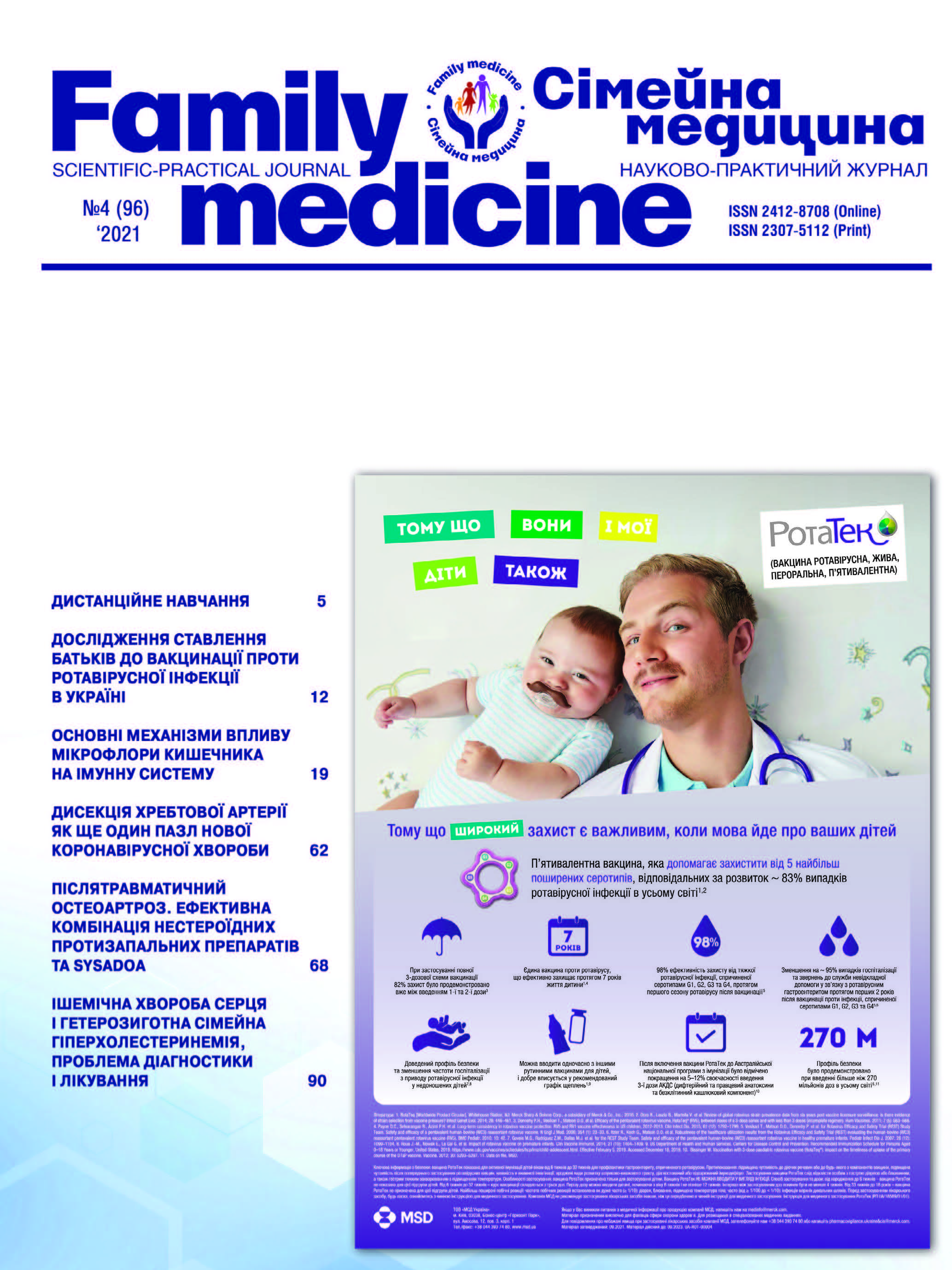Treatment of arterial hypertension with diuretics depending on patient’s salt sensitivity
##plugins.themes.bootstrap3.article.main##
Abstract
At present WHO considers arterial hypertension (AH) as the most frequent cause of death that can potentially be prevented. Timely diagnosis, preventive measures, and use of the adequate pharmacotherapy delays the progression of the disease, reduces the risk of complications, improves the quality of life and helps to maintain working capacity.
The onset and progression of hypertension is associated with numerous risk factors, including environmental, genetic factors and the negative habits. The medical analytical literature provides evidence for the relationship between the amount of salt consumed and the hypotensive efficacy of diuretic drugs in patients with hypertension and genetic polymorphism.
The objective: to study the effect of thiazide diuretics on the level of blood pressure depending on the Gly460Trp polymorphism of the ADD1 gene.
Materials and methods. The study involved 120 patients of the Ukrainian population with a diagnosis of stage II hypertension (main group) and 112 apparently healthy individuals (control group). The method of Weinberger MN (1986) was used to determine the type of salt sensitivity. The Gly460Trp polymorphism of the ADD1 gene was determined by PCR. Patients of the main group were divided into two treatment groups: group I (60 people) received indapamide retard 1.5 mg daily, group II (60 people) – hydrochlorothiazide 25 mg daily.
Results. Among 120 hypertensive patients, 75.8% were homozygotes for the G-allele, 21.7% – were heterozygotes and 2.5% – homozygotes for the T-allele. There were 2 times more sick carriers of the T-allele than healthy individuals (p˂0.05). In subgroup Ia (carriers of the GG genotype), the decrease in the level of mean daily SBP (ΔSBP) was 16.5 mmHg, among carriers of the T-allele – 49.8 mm Hg, in subgroup Ib – 12.6 and 26, 3 mm Hg respectively. The antihypertensive effect of treatment in carriers of the T-allele of group I was 2 times greater. In subgroup IIa (carriers of the GG genotype), the decrease in ΔSBP was 18.5 mmHg, and in carriers of the T-allele – 29.8 mm Hg. (p˂0.05). In subgroup IIb – 16.4 and 31.3 mm Hg. respectively. Therefore, the use of thiazide diuretics in carriers of T-allele gives the best hypotensive result and does not depend on salt sensitivity.
Conclusion. Patients with hypertension have a significantly higher frequency of the T-allele G460T of the ADD1 gene compared to healthy individuals (12.5% vs 6.7%). The presence of the T-allele in the genotype of a patient with AH is a predictor of the successful use of thiazide diuretics.
##plugins.themes.bootstrap3.article.details##

This work is licensed under a Creative Commons Attribution 4.0 International License.
Authors retain the copyright and grant the journal the first publication of original scientific articles under the Creative Commons Attribution 4.0 International License, which allows others to distribute work with acknowledgment of authorship and first publication in this journal.
References
Asotsiatsiia kardiolohiv Ukrainy. Arterialna hipertenziia. Klinichna nastanova, perehliad 2016. Available from: http://dec.gov.ua/wp-content/uploads/2019/11/kn_artergipert.pdf
Babkin, A.P., Gladkikh V.V., Pershukov I.V. Chuvstvitelnost k soli bolnykh arterialnoj gipertenziej. Kardiologiya. 2010;10:57-62.
Bobrishev, K.A., Kolomi`yecz, V.V. Solova gipoteza – pro et contra: diskusiyi shhodo roli natriyu khloridu u viniknenni ta rozvitku arterialnoyi gipertenziyi .Sercze i sudini. 2010;1:84-92.
Poteshkina N.G. Izbytochnoe potreblenie soli: rasprostranennost i posledstviya dlya zdorovya cheloveka (obzor literatury). Vestnik RGMU. 2013;2:29-33.
Fatula, M.I., Mashura, G.Yu. Arterial’na gipertenziya i khlorid natriyu. Naukovij visnik Uzhgorodskogo universitetu, seriya «Mediczina». 2015;1(51):259-65.
Ambard L., Beaujard E. Causes de l’hypertension erterielle . Arch. Gen. Med. 1904; 1: 520-533.
Cameron, A.C., Lang, N.N., Touyz, R.M. Drug treatment of hypertension: focus on vascular health. Drugs. 2016;76(16):1529-50. Available from: https://doi.org/10.1007/s40265-016-0642-8
Cooper-DeHoff Rhonda M., Johnson J.A. Hypertention pharmacogenomics: in search of personalized treatment approaches. Nat Rev Nephrol. 2016;12(2):110-22. Available from: https://doi.org/10.1038/nrneph.2015.176
Dubovyk Ye. І., Harbuzova V.Yu., Ataman А V. G-1639A but Not C1173T VKORC1 Gene Polymorphism Is Related to Ischemic Stroke and Its Various Risk Factors in Ukrainian Population. BioMed Research International. 2016. Article ID 1298198.10. Available from: http://dx.doi.org/10.1155/2016/1298198
Gupta S., Jhawat V., Agarwal B. K.[et al.]. Alpha Adducin (ADD1) Gene Polymorphism and New Onset of Diabetes Under the Influence of Selective Antihypertensive Therapy in Essential Hypertension. Curr Hypertens Rev. 2019;15(2):123-34. Available from: https://doi.org/10.2174/1573402114666180731111453
Intersalt Cooperative Research Group. Intersalt: an international study of electrolyte excretion and blood pressure. Results for 24 hour urinary sodium and potassium excretion. BMJ. 1988;297(6644):319-28.
Jing rui Zhang, Wan ning Hu, Chang yi Li A. Review of the Epidemiological Evidence for Adducin Family Gene Polymorphisms and Hypertension. Cardiology Research and Practice. 2019; 2. Available from: https://doi.org/10.1155/2019/7135604
Joossens I.V., Gebors J. Salt and hypertension. Prev. Med. 1983;12:53-9.
Kempner W. Treatment of hypertensive vascular disease with rice diet . Am. J. Med. 4. 1948. 545-77.
Manosroi W, Williams GH. Genetics of Human Primary Hypertension: Focus on Hormonal Mechanisms. Endocr Rev. 2019, Jun 1;40(3):825-56. DOI: 10.1210/er.2018-00071
Manunta P., Ferrandi M., Cusi D. [et al.]. Personalized Therapy of Hypertension: the Past and the Future. Curr Hypertens Rep. 2016;18(3):24. Available from: https://doi.org/10.1007/s11906-016-0632-y
Norm RC, Campbell MD, Correa-Rotter R, [et al.]. Proposed nomenclature for salt intake and for reductions in dietary salt. J. Clin. Hypertens. (Greenwich). 2015; 17(4):247-51.
Oliveira-Paula G.H., Pereira S.C. Pharmacogenomics And Hypertension: Current Insights. Pharmacogenomics and Personalized Medicine. 2019;12.341-59. Available from: https://doi.org/10.2147/PGPM.S230201
Orlova Y.A., Kurlykina N.V., Seredenina E.M. Thiazide and Thiazide-Like Diuretics in Therapy of Arterial Hypertension. Kardiologiia. 2019;59(11):84-94. Available from: https://doi.org/10.18087/cardio.2019.11.2653
Singh M, Singh AK, Pandey P [et al.]. Molecular genetics of essential hypertension. Clin Exp Hypertens. 2016;38(3):268-77. DOI: 10.3109/10641963.2015.1116543
Unger T., Borghi C., Charchar F.[et al.]. 2020 International Society of Hypertension Global Hypertension Practice Guidelines. Hypertension. 2020;75:1334-57. Available from: https://doi.org/10.1161/HYPERTENSIONAHA.120.15026
Wei L. Au A., Teh L.K., [et al.]. Recent Advances in the Genetics of Hypertension. Adv Exp Med Biol. 2017;956:561-81. Available from: https://doi.org/10.1007/5584_2016_75
Weinberger MH, Fineberg NS, Fineberg E, Weinberger M. Salt sensitivity, pulse pressure, and death in normal and hypertensive humansю Hypertens. 2001;37(2):429-32.





